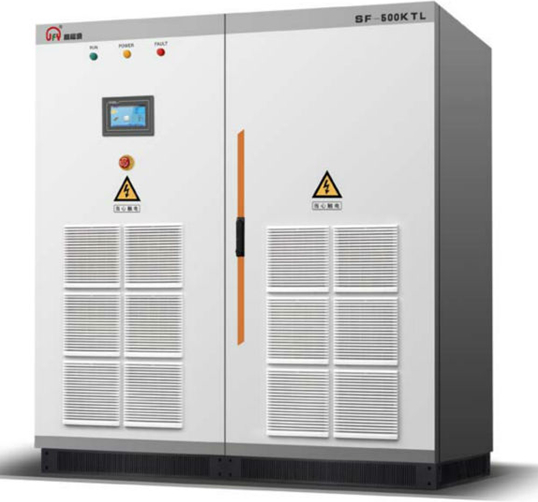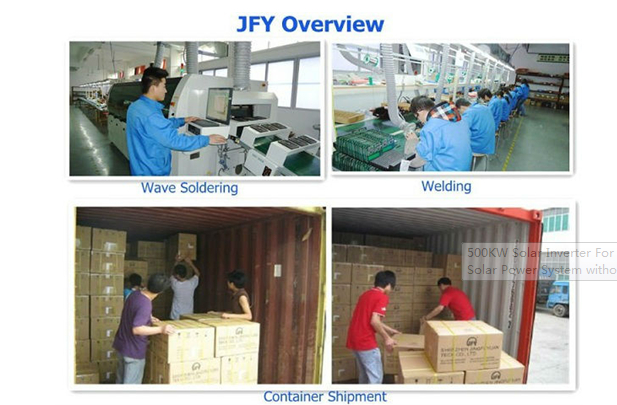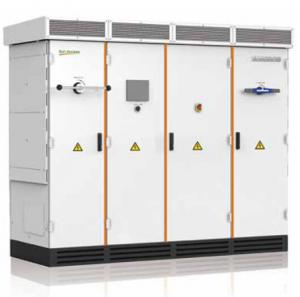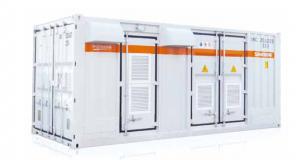500KW Solar Inverter For Solar Power Plant or Solar Power System without Transformer
- Loading Port:
- China main port
- Payment Terms:
- TT or LC
- Min Order Qty:
- 10 unit
- Supply Capability:
- 1000 unit/month
OKorder Service Pledge
OKorder Financial Service
You Might Also Like
1. Structure of 500KW Solar Inverter for Solar Power Plant or Solar Power System without Transformer Description
A solar inverter, or PV inverter, or Solar converter, converts the variable direct current (DC) output of a photovoltaic (PV) solar panel into a
utility frequency alternating current (AC) that can be fed into a commercial electrical grid or used by a local, off-grid electrical network. It is
a critical BOS–component in a photovoltaic system, allowing the use of ordinary AC-powered equipment. Solar inverters have special
functions adapted for use with photovoltaic arrays, including maximum power point tracking and anti-islanding protection.
2. Main Features of 500KW Solar Inverter for Solar Power Plant or Solar Power System without Transformer
• With the advanced system intelligence, highly speed MPPT technology, industrial-grade engineeringand compete fault
protections,Sunforest series central commercial inerters maximize system uptime and power production, even in harshest
environments
• DSP-controlled IGBT circuitry to achieve high efficiency, reliability and low installing cost.
• Sunforest KT series grid-tied inverters are integrated with an isolatin transformer
• Multiple work mode, SVG(Static Var Generator) mode, Anti-Reverse power control mode
Utility-read features
• Open communication protocol, good compatible with any third-party monitoring system and easily integrated into SCADA
systems
• Remote control of real and reactive power
• LVRT(Low voltage ride through)
• Power factor control
• Simplified grid interconnection
Optimal MPPT technology
• Rapid and accurate control boost PV plant KWH yield
• Provides a wide range of operation voltage
3. 500KW Solar Inverter for Solar Power Plant or Solar Power System without Transformer Images



4. 500KW Solar Inverter for Solar Power Plant or Solar Power System without Transformer Specification
Max. DC Input Power | 285KW | 570KW | 715KW |
Max DC Voltage | 1000Vdc | ||
MPPT Operating Range | 450~820Vdc | ||
Number of Parallel Inputs | 5 | 12 | |
Number of MPP Trackers | 1 | ||
Max. Input Current | 600A | 1200A | 1400A |
Nominal Output Power | 250KW | 500KW | 630KW |
Max. Output Power | 275KW | 550KW | 693KW |
Nominal Output Current | 535A | 1070A | 1155A |
Max. Output Current | 589A | 1177A | 1270A |
Nominal AC Output Voltage | 270Vac | 270Vac | 315Vac |
AC Output Voltage Range | 243~297Vac | 283~347Vac | |
AC Grid Frequency Range | 50Hz | ||
Power Factor (cosφ) | 0.9(leading)~0.9(lagging) | ||
THDI | <3% | ||
Max.efficiency | 98.40% | 98.50% | 98.60% |
Euro.efficiency | 98.00% | 98.00% | 98.20% |
MPPT. efficiency | 99.90% | 99.90% | 99.90% |
Operating Temperature | -25°C~+60°C(derated power above50°C) | ||
Altitude | 6000m(derated power above 3000m) | ||
Noise (typical) | <65dB(A) | ||
Operating Consumption | <100W | ||
Electrical Isolation | Transformerless | ||
Cooling Concept | Fan Cooling | ||
Protect Level | IP20 | ||
Communication | RS485 | ||
Dimension (W×D×H)(mm) | 1000*900*1850 | 1700*900*1850 | 1700*900*1850 |
Weight (Kg) | 890 | 1427 | 1677 |
5. FAQ of 500KW Solar Inverter for Solar Power Plant or Solar Power System without Transformer
Q1:Can we visit your factory?
A1:Sure,welcome at any time,seeing is believing.
Q2:Which payment terms can you accept?
A2:T/T,L/C,Moneygram,Paypal are available for us.
- Q:What is the maximum AC voltage that a solar inverter can provide?
- The maximum AC voltage that a solar inverter can provide depends on the specifications of the specific inverter model. However, for most common residential and commercial solar inverters, the maximum AC voltage typically ranges between 208 and 240 volts.
- Q:How does a solar inverter handle shading or partial panel obstructions?
- A solar inverter handles shading or partial panel obstructions by employing a technique called maximum power point tracking (MPPT). MPPT allows the inverter to constantly monitor the output of each individual solar panel and adjust its operating conditions to maximize power production. When shading or partial obstructions occur, the inverter intelligently redistributes the power flow to avoid any significant drop in overall system performance. This ensures that the panels operate at their optimal efficiency, even under less than ideal conditions.
- Q:What is the role of a solar inverter in a residential system?
- The role of a solar inverter in a residential system is to convert the direct current (DC) electricity produced by solar panels into alternating current (AC) electricity that can be used to power household appliances and be fed back into the grid if there is excess energy. Additionally, the inverter ensures the efficiency and safety of the system by monitoring and regulating the flow of electricity.
- Q:What is the role of a solar inverter in reactive power compensation?
- The role of a solar inverter in reactive power compensation is to monitor and regulate the reactive power flow in the electrical system. It helps maintain a power factor closer to unity by injecting or absorbing reactive power as needed. This is crucial for improving the overall efficiency and stability of the grid, as well as reducing voltage fluctuations and line losses.
- Q:What is the maximum AC power output of a solar inverter?
- The maximum AC power output of a solar inverter varies depending on the specific model and capacity. It can range from a few hundred watts for small residential inverters to several megawatts for large commercial or utility-scale inverters.
- Q:Can a solar inverter be used with electric vehicles?
- Yes, a solar inverter can be used with electric vehicles. Solar inverters are used to convert the DC (direct current) electricity generated from solar panels into AC (alternating current) electricity which can be used to power various devices, including electric vehicles. This allows for the charging of electric vehicles with clean and renewable solar energy.
- Q:What is a solar inverter?
- A solar inverter is an essential component of a solar power system that converts the direct current (DC) generated by solar panels into alternating current (AC) electricity suitable for use in households and businesses. It ensures optimal performance and connectivity between the solar panels and the electrical grid, allowing for efficient utilization of solar energy.
- Q:Can a solar inverter be used with different types of solar panel mounting systems?
- Yes, a solar inverter can be used with different types of solar panel mounting systems. The solar inverter is responsible for converting the direct current (DC) generated by the solar panels into alternating current (AC) that can be used to power electrical devices. The mounting system, on the other hand, is used to securely install the solar panels in various locations such as rooftops, ground mounts, or pole mounts. As long as the solar panels are compatible with the inverter's specifications and the mounting system is properly installed, the solar inverter can be used with different types of solar panel mounting systems.
- Q:How does a solar inverter handle harmonics in the grid?
- A solar inverter handles harmonics in the grid by incorporating filters and control algorithms that mitigate the impact of harmonics. These filters help in reducing the distortion caused by harmonics, ensuring that the solar inverter operates efficiently and does not introduce additional harmonics into the grid. The control algorithms continuously monitor the grid's harmonics and adjust the inverter's output accordingly to maintain compliance with the grid's harmonic standards.
- Q:Can a solar inverter be used in a solar-powered data center?
- Yes, a solar inverter can be used in a solar-powered data center. A solar inverter is an essential component of a solar power system as it converts the direct current (DC) generated by solar panels into alternating current (AC) that can be used to power electrical devices in a data center. By using a solar inverter, a solar-powered data center can efficiently utilize the electricity generated from solar panels to meet its power requirements.
1. Manufacturer Overview |
|
|---|---|
| Location | |
| Year Established | |
| Annual Output Value | |
| Main Markets | |
| Company Certifications | |
2. Manufacturer Certificates |
|
|---|---|
| a) Certification Name | |
| Range | |
| Reference | |
| Validity Period | |
3. Manufacturer Capability |
|
|---|---|
| a)Trade Capacity | |
| Nearest Port | |
| Export Percentage | |
| No.of Employees in Trade Department | |
| Language Spoken: | |
| b)Factory Information | |
| Factory Size: | |
| No. of Production Lines | |
| Contract Manufacturing | |
| Product Price Range | |
Send your message to us
500KW Solar Inverter For Solar Power Plant or Solar Power System without Transformer
- Loading Port:
- China main port
- Payment Terms:
- TT or LC
- Min Order Qty:
- 10 unit
- Supply Capability:
- 1000 unit/month
OKorder Service Pledge
OKorder Financial Service
Similar products
New products
Hot products
Hot Searches
Related keywords

































